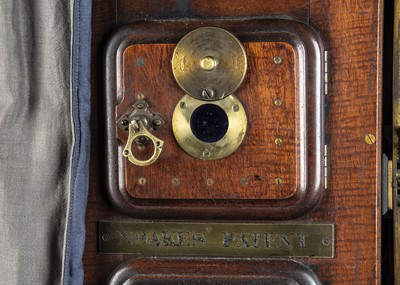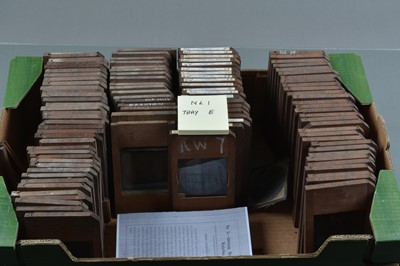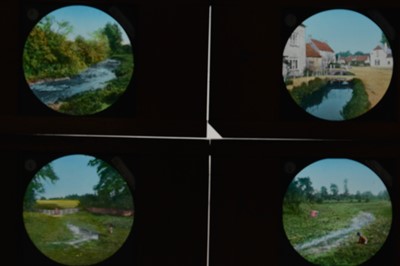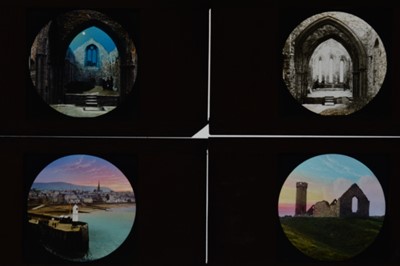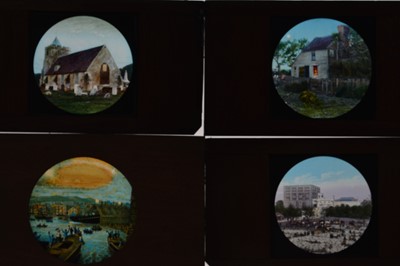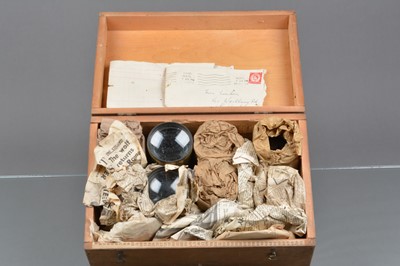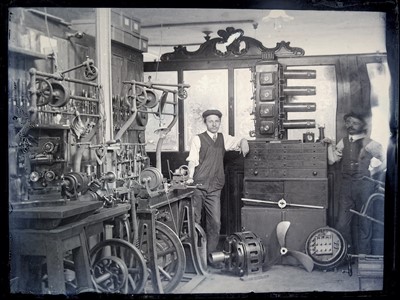The Noakes 'Quad' Magic Lantern or Noakesoscope (Special Auction Services wishes to extend its gratitude to Dr Richard Crangle for the following lot description and analysis), description - the lantern body of single, unitary mahogany and lacquered brass construction (not triunial with a demountable ‘single’ or two stacked biunials), but stands no taller than the average triunial: 35 inches including the baseplate, plus 2 inches for the detachable domed top and maybe another 6 inches for the absent chimney cowl; the body is 10 inches long and 9¼ inches wide, attached to its baseplate (23 by 11 inches) by two hinges along its back edge – this allows it to be tilted to elevate the lenses by around 10 degrees, secured by rotary clamps at the front corners ;there are no lifting handles; all references to ‘right’ and ‘left’ here refer to the sides of the lantern when looking ‘forward’ towards its lenses; there are four hinged access doors (6½ by 5¾ inches) on the right side, aligned with the illuminant chambers inside, and four dummy doors (moulded wooden panels screwed onto the body, complete with fake catches and inspection windows) in matching positions on the left side; the interior of the body is lined with tinned iron sheet spaced from the wood; the original chimney cowl is missing (and also not visible in a 1940s photograph); the chimney hole in the lantern top has been blanked off with a metal sheet to prevent light escaping upwards; from the ‘workshop’ photo the chimney cowl appears to have been a standard Noakes pattern; there are three sets of objective lenses (6, 8 and 10 inch focal length) and a set of lens extension tubes - these allow configurations for projection in spaces ranging from a small parlour (Gordon Noakes used the lantern in his home) up to the Albert Hall (around 130 feet [40m] ‘throw’, giving an image width of 40 feet [12m]); there are also, unusually, five extra sets of condenser lenses of varying convexity and focal length, which could be swapped in and out of the cylindrical condenser mounts within the lantern body to give further variations; in other words this was the travelling set-up of a highly professional, indeed perfectionist, lanternist who knew exactly how to achieve the best effect in different situations; it was originally illuminated by limelight: screw holes in the back of the lantern correspond to the mountings of a dissolving gas tap and pipe fastenings, as seen in the ‘workshop’ photograph; however there are references in accompanying press cuttings to electric arc illumination, so it was modified at some stage (perhaps by Gordon Noakes); the current lamp fittings, which are fed by post-1970s cables arranged neatly on the back of the lantern, are bayonet mountings for large 500-watt projector bulbs, which are mounted on horizontal bars with thumbscrews for lateral adjustment relative to the lantern body, which probably relate to the electric arcs rather than being original (they are not visible in the ‘workshop’ photograph); dimensions of lantern - 920mm high, 690mm deep, 280mm, dimensions of iron-bound wooden lantern-carrying chest - 970mm high, 640mm wide, 330mm deep, dimensions of iron-bound wooden slide chest- 840mm high, 660mm wide, 350mm deep. Analysis - the 'Noakes Quad' was a ‘workhorse’ rather than a ‘show pony’ – compared to some triunials there is no ostentatious decoration, beyond the typical wooden beading, shaped chimney and brass fittings contrasting with the mahogany body; this may reflect its being built for Noakes’s own use, rather than in the hope of attracting commercial orders; it shows signs of considerable use: some of the metal surfaces are rubbed and worn, and there is localised charring to the wooden body; rather surprisingly, the four lenses are not aligned along the vertical centre-line of the lantern body, being one inch closer to the right side than to the left: there is no obvious practical explanation for this; the same arrangement is replicated inside the body, where the metal lining includes an additional spacing chamber at the left side, running through all four compartments; both sides carry engraved brass plates reading ‘NOAKES’ PATENT'; however, no patent for a four-lens lantern is known, and it is unlikely that such an ‘invention’ would have been patentable anyway, being just an extension of the principles well-known in the ‘prior art’ of biunial and triunial lanterns.; if the four-lens configuration had been patented, we might expect it to have been made commercially: patents require the invention to find commercial success to recoup the initial and ongoing fees; the ‘Noakes Patent’ designation must refer to one or more detailed design refinements, probably the same ones claimed by similar plates on Noakes’s triunials; the right side also has a brass maker’s plate at the top, reading: 'D.W. NOAKES, “PLEYDELL”, HUMBER ROAD, WESTCOMBE PARK S.E.'; that is the address recorded for Noakes in the 1901 Census, and is probably the house at Westcombe Park mentioned as “lately purchased” in an 1897 OMLJ interview, where he lived until around 1924; the plate could, of course, have been added later, though it is overlaid by other fittings and looks original; if it was attached during construction, the lantern can have been made no earlier than 1896; there is other circumstantial evidence on dating: Noakes published a small booklet listing lectures he offered, giving the same Humber Road address and including the remark that “I have constructed a Quadruple projection apparatus (the only one existing)"; the booklet quotes glowing press reviews, including one praising a “very fine lantern, which was manipulated with practised skill” – however the original 1893 newspaper source used the wording “very fine patent triple lantern;” in other words the Quad was not in use in 1893, yet it definitely was in use by 1901, when (the earliest press reference found so far) a lecture by Pastor Charles Spurgeon was supported by “Mr D.W. Noakes with his Quadruple Dioramic Lantern". Magic Lantern Slides - the 'Noakes Quad' magic lantern to be offered with large collection of mahogany-mounted 3¼sq. in. magic lantern slides, mainly photographic and coloured photographic, being the working collection of David Noakes as a professional lanternist, including slides from 11 out of the 12 readings in Noakes' printed 'Syllabus of Dioramic Lectures', probably printed circa 1901 (treating No. 12 and No. 13 'England Bisected by a Steam Launch' as one set, missing only No. 3 'A Visit to Cloudland'), three period copies of the Syllabus included in lot, some sets in the Syllabus including effects, with occasional rackwork slides, contents of each set not checked for completeness, some slides for use in more than one set - sets detailed as : No. 1 'The Victorian Era' (122), No. 2 'Picturesque Devon' (50), No. 4 'Rambles in Normandy and Brittany' (78), No. 5 'Antwerp, Brussels and Waterloo' (54), No. 6 'River Rambles or The Strange Adventures of a Steam House Boat' (69), No. 7 'The Channel Islands through my Camera' (99), No. 8 'Manxland & its Beauties' (70), No. 9 'Tamesis', including 'RW', probably Raising Wrecks (104), No. 10 'The Greatest Cities of the World' (95), No. 11 'Ancient and Modern Methods of Travelling' (82), No. 12 'England Bisected by a Steam Launch Part 1 The Outward Journey and Part II The Homeward Journey', journey undertaken in his steam launch 'Lizzie', commencing August 1890, see journal in this lot (219), with named sets not listed, including Paris Exhibition (74), 'Tour Through Cornwall' (30), 'Bill Adams The Hero of Waterloo', duplicate title (14), York & Son 'Gabriel Grub' (16), Carpenter & Westley 'Scrooge' (14), 'The Great European War' (30), chromatrope set, in original box, with a quantity of apx 280 static slides, slide changers, effects, chromatropes, rackwork and slipping slides, some with manuscript titles (apx 1,500 slides in total), with 3¼in sq photographic negative title slides, as made and used by David and Gordon Noakes (26), quarter-plate glass negatives - 'Noakes Quad' in workshop, a Noakes Triunial magic lantern on display at an exhibition in Lewes, circa 1890, horse tramcars in Greenwich, all probably by or commissioned by David Noakes, with wooden box of quarter-plate glass negatives and copy-negatives, the manuscript 'Log of the "Lizzie"', 1890, Noakes' steam launch, with newspaper cutting referring to photographs taken on the trip, and resulting magic lantern lecture, with two Russian iron and brass magic lanterns, a.f., various parts, lenses and elements, electric lamp bulbs, brass camera lenses including Dallmeyer 3D, serial no. 27052, 1878, elements a.f, Taylor, Taylor & Hobson whole plate, and various notes of history, family history and provenance, literature, cuttings and pamphlets from the Noakes and Harold era of ownership of the collection (a lot) Please refer to Camera Department concerning condition of the 'Noakes Quad' magic lantern



